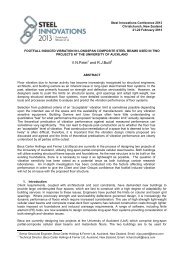Environmental Impacts of Multi-Storey Buildings Using Different ...
Environmental Impacts of Multi-Storey Buildings Using Different ...
Environmental Impacts of Multi-Storey Buildings Using Different ...
Create successful ePaper yourself
Turn your PDF publications into a flip-book with our unique Google optimized e-Paper software.
the GreenStar assessment considering the concrete building option to be optimal. The presumption<strong>of</strong> GreenStar NZ and most green building rating systems is that recycled materials willautomatically result in reduced environmental burdens. However, this may not always be the caseand recycling in any given situation may be a positive or negative attribute. For example recyclingcan save landfill space, but the process <strong>of</strong> recycling <strong>of</strong> any given product may take more energyand adversely affect air quality more than production from raw materials. The focus on recyclingcan ignore the possibility and give more weight to solid waste and resource depletion issues thanglobal warming or other measures. One issue or indicator does not take precedence over theother, but commonly held assumptions can drive the shape <strong>of</strong> rating tools over data and facts whendecisions are made during tool planning. It may be prudent to re-visit the objective <strong>of</strong> recyclingduring the review phase <strong>of</strong> the GreenStar NZ tool to align the ratings to the initial aim to reduce theflows from and to nature.There were found to be aspects <strong>of</strong> the GreenStar NZ tool that were constrained when trying to fullyintegrate LCA-based tools into this building rating system. Two, in particular deserve emphasis; theproblem <strong>of</strong> data availability, and the absence <strong>of</strong> appropriate references or benchmarks againstwhich to judge LCA results for a particular building.GreenStar NZ is clear in its aims and in some cases is driving better practice; The energy creditsaim to reduce greenhouse emissions from operation <strong>of</strong> the building (carbon dioxide emissions), touse energy more efficiently and reduce peak loads. The reality is that energy rating is heavilydependent upon building fabric, building services systems and expected electrical and mechanicalloadings. In the majority <strong>of</strong> modern buildings there is a fine balance between natural light andthermal gain. The Façade is also an important factor in determining the final energy rating. Thissupports the notion that a more holistic measure is required to capture all these linked aspects <strong>of</strong>the energy equation. The material credits aim to minimise resource consumption through materialselection, use and re-use initiatives, support third party life cycle assessment programs andefficient management practices. There are gaps in the data currently available to populate thirdparty verification schemes such as <strong>Environmental</strong> Choice due to the lack <strong>of</strong> independently verifiedspecifications available through accredited suppliers. This is an active area <strong>of</strong> research and as databecomes available it will inform the GreenStar tools. Recycled steel and concrete at this stage arenot practical due to a lack <strong>of</strong> information available from suppliers and indeed a lack <strong>of</strong> choice <strong>of</strong>products. In addition, as previously discussed, recycling may not always prove to be the bestenvironmental choice.The integrated interior fit-out strategy is important and does drive efficiency in management. Amajor limitation in the material category is the lack <strong>of</strong> environmental choice products for developersto choose from and be confident that they are making a sound decision.In order to encourage the uptake <strong>of</strong> LCA and incorporate all estimated effects and not proxymeasures it will be necessary to educate the public as to why informed environmental choice isimportant. It will be important to emphasise the need for assessing whole buildings and theinherent relationships in a building system where the choice <strong>of</strong> one material for an application maydictate the use <strong>of</strong> other materials for thermal or other reasons.Status Draft 16.07.2008Project NumberOur Ref − MWH Scion GreenStar Assessment PeerReviewFINAL.doc
















